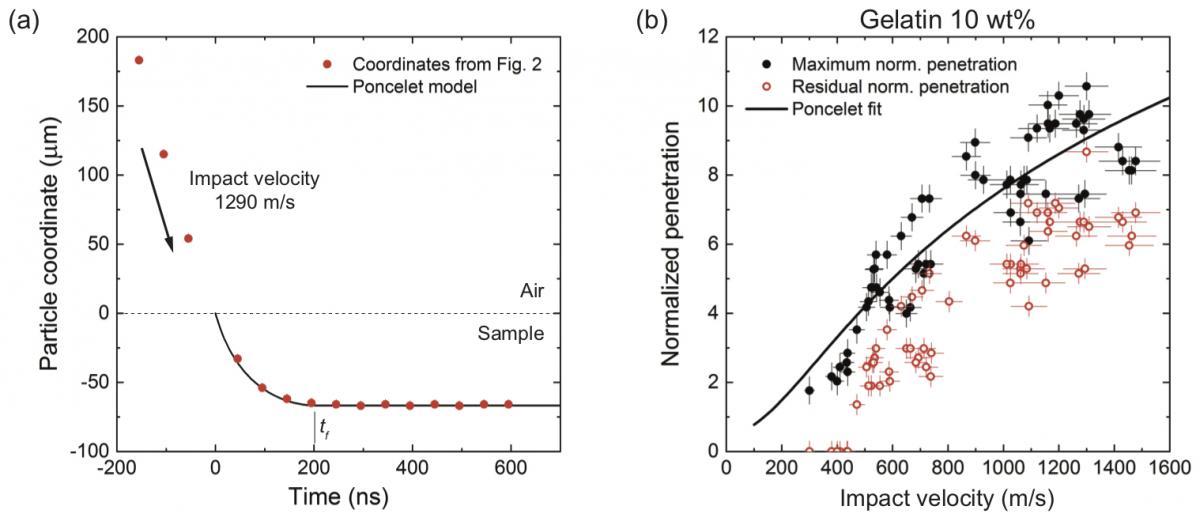- Studying the high-rate mechanical behavior of tissues or tissue simulants can help in the understanding of ballistic and explosive–related injuries and lead to better forensic interpretation in cases that involve such injuries. In the field of biolistics, microparticles launched at supersonic velocities are used as carriers to deliver therapeutic substances into cells and tissues. However, most studies have been based on post-mortem or ex-vivo analysis wherein the final penetration depth of the micro-particle is often the only quantity that is measured and the full impact history such as the dynamic extent of tissue damage and tissue recovery remains unknown.
- In a recently published paper, we used our laser-induced particle impact test (LIPIT) and monitored impact and penetration into gelatin and synthetic hydrogel samples at velocities up to ~1500 m/s using a high-speed multi-frame camera that can record up to 16 images with nanosecond time resolution.
- The trajectories of the particles in the gels were compared with a Poncelet model for particle penetration, demonstrating good agreement between experiments and the model for impact in gelatin.
- We found that the strength resistance parameter in the Poncelet model is two orders of magnitude higher than in macroscopic experiments at comparable impact velocities.

FIG. 1 Multi–frame sequence showing a high-velocity impact on 10 wt% gelatin at 1290 m/s. The particle hits the sample surface 100 ns after the first frame is acquired. A small splash forms and develops upwards. The maximum penetration is reached within 200-250 ns after impact. The white dashed line illustrates the position of the particle versus time. An image taken a few seconds after the impact events shows the residual penetration of the particle. The interframe time is shown at the top of the frames and the exposure time is 10 ns for all frames.
- Particle trajectories as well as maximum and residual penetrations were extracted from image sequences such that shown as in Fig. 1 for velocities ranging from ~200 m/s to ~1500 m/s.
- In the present high Weber, high Froude, and high elastic Froude numbers regime, the force, F, that is experienced by the particle can be expressed as a polynomial of the velocity v, known as the Poncelet model:

The maximum penetration depth, PMax, can be solved as:
where d is the particle diameter, ρp is the density of the particle, ρs is the density of the sample, CD is the drag coefficient, v0 is the particle impact velocity, and R is a strength resistance term that is fitted.

FIG. 2. (a) Particle trajectory corresponding to the impact shown in Fig. 2, where the particle impacts a 10 wt% gelatin sample at 1290 m/s. The trajectory is compared with the Poncelet model and the fitted parameter R obtained from the maximum penetration data. (b) Normalized maximum and residual penetrations as a function of impact velocity for impacts on 10 wt% gelatin. The maximum penetration data are fitted with the Poncelet model and the resistance R as a parameter.
- The results suggest that the model can reasonably predict micro-particle penetration and serve as the first step towards more elaborate models for deformation of soft materials at high strain rates.
- We also find that the resistance values, as described in the Poncelet model, obtained under high-speed microscopic impacts differ by orders of magnitude compared to high-speed macroscopic impacts, justifying the need for such in-situ experiments.
- We envision that an enhanced prediction of tissue or tissue-simulant responses under impact will guide the development of micrometer-sized drug delivery carriers and help better assess the threat of micro-debris in explosive-related injuries.
For more details, read the paper:

